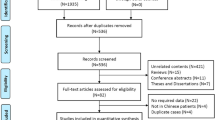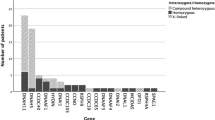Summary
INTRODUCTION: Primary ciliary dyskinesia (PCD) is a rare hereditary recessive disease with symptoms of recurrent pneumonia, chronic bronchitis, bronchiectasis, and chronic sinusitis. Chronic rhinitis is often the presenting symptom in newborns and infants. Approximately half of the patients show visceral mirror image arrangements (situs inversus). In this study, we aimed 1) to determine the number of paediatric PCD patients in Austria, 2) to show the diagnostic and therapeutic modalities used in the clinical centres and 3) to describe symptoms of children with PCD. PATIENTS, MATERIAL AND METHODS: For the first two aims, we analysed data from a questionnaire survey of the European Respiratory Society (ERS) task force on Primary Ciliary Dyskinesia in children. All paediatric respiratory units in Austria received a questionnaire. Symptoms of PCD patients from Vienna Children's University Hospital (aim 3) were extracted from case histories. RESULTS: In 13 Austrian clinics 48 patients with PCD (36 aged from 0–19 years) were identified. The prevalence of reported cases (aged 0–19 yrs) in Austria was 1:48000. Median age at diagnosis was 4.8 years (IQR 0.3–8.2), lower in children with situs inversus compared to those without (3.1 vs. 8.1 yrs, p = 0.067). In 2005–2006, the saccharine test was still the most commonly used screening test for PCD in Austria (45%). Confirmation of the diagnosis was usually by electron microscopy (73%). All clinics treated exacerbations immediately with antibiotics, 73% prescribed airway clearance therapy routinely to all patients. Other therapies and diagnostic tests were applied very inconsistently across Austrian hospitals. All PCD patients from Vienna (n = 13) had increased upper and lower respiratory secretions, most had recurring airway infections (n = 12), bronchiectasis (n = 7) and bronchitis (n = 7). CONCLUSION: Diagnosis and therapy of PCD in Austria are inhomogeneous. Prospective studies are needed to learn more about the course of the disease and to evaluate benefits and harms of different treatment strategies.
Zusammenfassung
EINLEITUNG: Die primäre Ziliendyskinesie (Primary Ciliary Dykinesia, PCD) ist eine seltene, meist autosomal-rezessiv vererbte Erkrankung, mit den typischen Manifestationen rezidivierende Pneumonien, chronische Bronchitis, Bronchiektasien, chronische Sinusitis und, insbesondere bei Neugeborenen und Säuglingen, chronischer Rhinitis. Die Hälfte der Patienten haben einen Situs inversus. Die Ziele dieser Studie waren, 1) die Anzahl pädiatrischer PCD-Patienten in Österreich zu erfassen, 2) die diagnostischen und therapeutischen Modalitäten der behandelnden Zentren darzustellen und 3) die Symptomatik der Patienten zu beschreiben. PATIENTEN, MATERIAL UND METHODEN: Zur Beantwortung der ersten zwei Fragen analysierten wir die österreichischen Resultate einer Fragebogenuntersuchung der pädiatrischen PCD Taskforce der European Respiratory Society (ERS). Die klinischen Charakteristika der PCD-Patienten an der Universitätsklinik für Kinder- und Jugendheilkunde in Wien stellten wir anhand der Krankengeschichten zusammen. ERGEBNISSE: In 13 österreichischen Krankenhäusern wurden 48 Patienten identifiziert (36 im Alter von 0–19 Jahre). Dies ergibt für Österreich eine Prävalenz diagnostizierter PCD-Patienten (0–19 Jahre) von 1:48000. Das mediane Alter bei Diagnose war 4,8 Jahre (IQR 0,3–8,2 Jahre). Patienten mit Situs inversus wurden früher diagsnotiziert (3,1 Jahre versus 8,1 Jahre; p = 0,067). Das gebräuchlichste screening-Verfahren (2005–2006) war der Saccharintest (45%), zur Diagnosesicherung wurde meist die Elektronenmikroskopie eingesetzt (73%). Alle Kliniken behandelten Exazerbationen sofort antibiotisch, Atemphysiotherapie wurde in 73% der Zentren eingesetzt. Insgesamt waren Diagnostik und Therapie der PCD in Österreich uneinheitlich. Alle Patienten der Universitätsklinik Wien (n = 13) hatten eine verstärkte Sekretproduktion, die meisten rezidivierende Atemwegsinfekte (n = 12), Bronchiektasen (n = 7) und Bronchitis (n = 7). KONKLUSION: Diagnostik und Therapie der PCD in Österreich sind uneinheitlich. Prospektive Studien sind notwendig, den Verlauf der Erkrankung zu erforschen sowie Nutzen und Schaden unterschiedlicher Therapie-konzepte darzustellen.
Similar content being viewed by others
Literatur
Coren ME, Meeks M, Morrison I, Buchdahl RM, Bush A (2002) Primary ciliary dyskinesia: age at diagnosis and symptome history. Acta Paediatr 91: 667–669
Meeks M, Bush A (2000) Primary ciliary dyskinesia (PCD). Pediatr Pulmonol 29: 307–316
O'Callaghan C, Chilvers M, Hogg C, Bush A, Lucas J (2007) Diagnosing primary ciliary dyskinesia. Thorax 62: 656–657
Ahrens P, Lettgen B (2006) Die primäre ziliäre Dyskinesie – Klinik, Diagnostik und Differentialdiagnostik; review. Atemwegs- und Lungenkrankheiten: Zeitschrift für Diagnostik und Therapie 32: 207–214
Biggart E, Pritchard K, Wilson R, Bush A (2001) Primary ciliary dyskinesia syndrome associated with abnormal ciliary orientation in infants. Eur Respir J 17: 444–448
Pifferi M, Caramella D, Cangiotti AM, Ragazzo V, Macchia P, Boner A (2007) Nasal nitrit oxide in atypical primary ciliary dyskinesia. Chest 131: 870–873
Bush A, Chodhari R, Collins N, Copeland F, Hall P, Harcourt J, et al (2007) Primary Ciliary Dyskinesia: current state of art. Arch Dis Child 92: 1136–1140
Bush A, Cole P, Hariri M, Mackay I, Phillips G, O'Callghan C, Wilson R, et al (1998) Primary ciliary dyskinesia: diagnosis and standards of care. Eur Respir J 12: 982–988
Kennedy MP, Noone PG, Leigh MW, Zariwala MA, Minnix SL, Knowels MR, et al (2007) High-resolution CT of patients with primary ciliary dyskinesia. AJR Am J Roentgenol 188: 1232–1238
Wodehouse T, Kharitonov SA, Mackay IS, Barnes PJ, Wilson R, Cole PJ (2003) Nasal nitrit oxide measurements for the screening of primary ciliary dyskinesia. Eur Respir J 21: 43–47
Roomans GM, Ivanovs A, Shebani EB, Johanesson M (2006) Transmission electron microscopy in the diagnosis of primary ciliary dyskinesia. Ups J Med Sci 11: 155–168
Ebsen M, Morgenroth K (2006) Elektronenmikroskopie bei der primären ziliären Dyskinesie; review. Atemwegs- und Lungenkrankheiten: Zeitschrift für Diagnostik und Therapie 32: 188–193
Höfler H, Gruber K, Stockinger L (1992) The technique of taking brush biopsies of the nasal mucosa for electron microscopy. Wien klin Wochenschr 104: 320–321
Popper H, Jakse R (1982) Diagnose und Aspekte zur Pathogenese des Kartagener-Syndroms an Hand von Nasenschleimhautbiopsien. Wien klin Wochenschr 94: 370–372
Barbato A, Frischer Th, Kuehni CE, Snijders D, Azevedo I, Baktai G, et al (2009) Primary ciliary dyskinesia: a consesus statement on diagnostic and treatment approaches and future prospectives. Eur Respir J ( revision)
Steinkamp G, Seithe H, Nüßlein T (2004) Therapie der primären Ziliendyskinesie. Pneumologie 58: 179–187
Fliegauf M, Benzing T, Omran H (2007) Cilia: Hair-like organelles with many links to disease. Nat Rev Mol Cell Biol 8: 880–893
Omran H, Horner N (2006) Genetische Defekte bei primärer ziliärer Dyskinesie; review. Atemwegs- und Lungenkrankheiten: Zeitschrift für Diagnostik und Therapie 32: 194–200
Frischer Th, Barbato A, Maurer E, Strippoli MPF, Kuehni CE (2009) Diagnosis and management of Primary Ciliary Dyskinesia in children: a European survey. Eur Respir J (submitted)
Kuehni CE, Frischer Th, Strippoli MPF, Maurer E, Bush A, Nielsen KG, et al (2009) Prevalence and characteristics of primary ciliary dyskinesia in children: a European survey. Eur Respir J (submitted)
Jain K, Padley SP, Goldstraw EJ, Kidd SJ, Hogg C, Biggart E, et al (2007) Primary ciliary dyskinesia in paediatric population: range and severity of radiological findings in a cohort of patients receiving tertiary care Clin Radiol 62: 986–993
Noone PG, Leigh MW, Sannuti A, Minnix SL, Carson JL, Hazucha M, et al (2004) Primary ciliary dyskinesia: diagnostic and phenotypic features. Am J Respir Crit Care Med 169: 459–467
Nüßlein TG, Rieger CHL (2005) Primäre Ziliendyskinesie: Diagnostik und Therapie. Monatsschrift Kinderheilkd 153: 255–261
Canciani M, Barlocco EG, Mastella G, De Santi MM, Gardi C, Lungarella G (1988) The saccharin method for testing mucociliary function in patients suspected of having primary ciliary dyskinesia. Pediatr Pulmonol 5: 210–214
Author information
Authors and Affiliations
Consortia
Corresponding author
Rights and permissions
About this article
Cite this article
Lesic, I., Maurer, E., Strippoli, MP. et al. Primäre Ziliendyskinesie in Österreich. Wien Klin Wochenschr 121, 616–622 (2009). https://doi.org/10.1007/s00508-009-1197-4
Received:
Accepted:
Issue Date:
DOI: https://doi.org/10.1007/s00508-009-1197-4
Keywords
- Primary ciliary dyskinesia
- Mucociliary clearance
- Situs inversus
- Sinusitis
- Bronchiectasis
- Epidemiology
- Diagnosis
- Therapy




